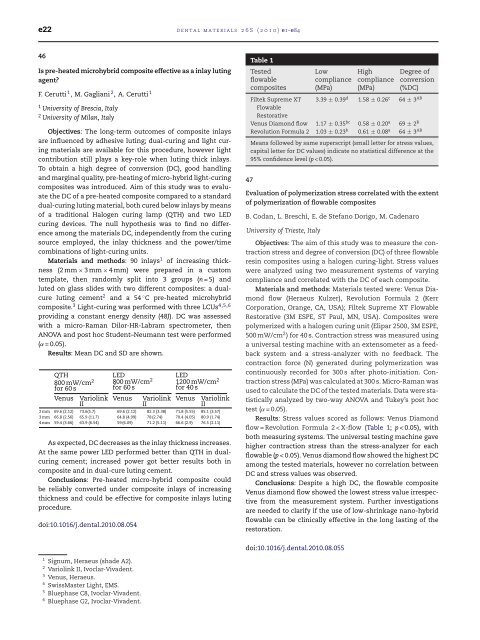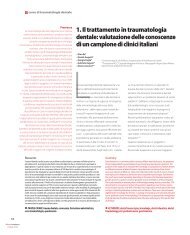Abstracts of the Academy of Dental Materials Annual ... - IsiRed
Abstracts of the Academy of Dental Materials Annual ... - IsiRed
Abstracts of the Academy of Dental Materials Annual ... - IsiRed
Create successful ePaper yourself
Turn your PDF publications into a flip-book with our unique Google optimized e-Paper software.
e22 dental materials 26S (2010) e1–e84<br />
46<br />
Is pre-heated microhybrid composite effective as a inlay luting<br />
agent?<br />
F. Cerutti 1 , M. Gagliani 2 , A. Cerutti 1<br />
1 University <strong>of</strong> Brescia, Italy<br />
2 University <strong>of</strong> Milan, Italy<br />
Objectives: The long-term outcomes <strong>of</strong> composite inlays<br />
are influenced by adhesive luting; dual-curing and light curing<br />
materials are available for this procedure, however light<br />
contribution still plays a key-role when luting thick inlays.<br />
To obtain a high degree <strong>of</strong> conversion (DC), good handling<br />
and marginal quality, pre-heating <strong>of</strong> micro-hybrid light-curing<br />
composites was introduced. Aim <strong>of</strong> this study was to evaluate<br />
<strong>the</strong> DC <strong>of</strong> a pre-heated composite compared to a standard<br />
dual-curing luting material, both cured below inlays by means<br />
<strong>of</strong> a traditional Halogen curing lamp (QTH) and two LED<br />
curing devices. The null hypo<strong>the</strong>sis was to find no difference<br />
among <strong>the</strong> materials DC, independently from <strong>the</strong> curing<br />
source employed, <strong>the</strong> inlay thickness and <strong>the</strong> power/time<br />
combinations <strong>of</strong> light-curing units.<br />
<strong>Materials</strong> and methods: 90 inlays 1 <strong>of</strong> increasing thickness<br />
(2 mm × 3mm× 4 mm) were prepared in a custom<br />
template, <strong>the</strong>n randomly split into 3 groups (n = 5) and<br />
luted on glass slides with two different composites: a dualcure<br />
luting cement 2 and a 54 ◦ C pre-heated microhybrid<br />
composite. 3 Light-curing was performed with three LCUs 4,5,6<br />
providing a constant energy density (48J). DC was assessed<br />
with a micro-Raman Dilor-HR-Labram spectrometer, <strong>the</strong>n<br />
ANOVA and post hoc Student–Neumann test were performed<br />
(˛ = 0.05).<br />
Results: Mean DC and SD are shown.<br />
QTH<br />
800 mW/cm2 for 60 s<br />
Venus Variolink<br />
II<br />
LED<br />
800 mW/cm 2<br />
for 60 s<br />
Venus Variolink<br />
II<br />
LED<br />
1200 mW/cm2 for 40 s<br />
Venus Variolink<br />
II<br />
2 mm 69.6 (2.12) 73.6(5.7) 69.6 (2.12) 82.3 (3.38) 71.8 (5.55) 85.1 (3.57)<br />
3 mm 66.8 (2.56) 65.9 (11.7) 64.8 (4.99) 78 (2.74) 70.4 (4.05) 80.9 (1.74)<br />
4 mm 59.4 (3.66) 63.9 (6.54) 59 (6.09) 71.2 (5.11) 66.6 (2.9) 76.5 (2.11)<br />
As expected, DC decreases as <strong>the</strong> inlay thickness increases.<br />
At <strong>the</strong> same power LED performed better than QTH in dualcuring<br />
cement; increased power got better results both in<br />
composite and in dual-cure luting cement.<br />
Conclusions: Pre-heated micro-hybrid composite could<br />
be reliably converted under composite inlays <strong>of</strong> increasing<br />
thickness and could be effective for composite inlays luting<br />
procedure.<br />
doi:10.1016/j.dental.2010.08.054<br />
1 Signum, Heraeus (shade A2).<br />
2 Variolink II, Ivoclar-Vivadent.<br />
3 Venus, Heraeus.<br />
4 SwissMaster Light, EMS.<br />
5 Bluephase C8, Ivoclar-Vivadent.<br />
6 Bluephase G2, Ivoclar-Vivadent.<br />
Table 1<br />
Tested<br />
flowable<br />
composites<br />
Low<br />
compliance<br />
(MPa)<br />
High<br />
compliance<br />
(MPa)<br />
Degree <strong>of</strong><br />
conversion<br />
(%DC)<br />
Filtek Supreme XT<br />
Flowable<br />
Restorative<br />
3.39 ± 0.39d 1.58 ± 0.26c 64 ± 3AB Venus Diamond flow 1.17 ± 0.35bc 0.58 ± 0.20a 69 ± 2B Revolution Formula 2 1.03 ± 0.23b 0.61 ± 0.08a 64 ± 3AB Means followed by same superscript (small letter for stress values,<br />
capital letter for DC values) indicate no statistical difference at <strong>the</strong><br />
95% confidence level (p < 0.05).<br />
47<br />
Evaluation <strong>of</strong> polymerization stress correlated with <strong>the</strong> extent<br />
<strong>of</strong> polymerization <strong>of</strong> flowable composites<br />
B. Codan, L. Breschi, E. de Stefano Dorigo, M. Cadenaro<br />
University <strong>of</strong> Trieste, Italy<br />
Objectives: The aim <strong>of</strong> this study was to measure <strong>the</strong> contraction<br />
stress and degree <strong>of</strong> conversion (DC) <strong>of</strong> three flowable<br />
resin composites using a halogen curing-light. Stress values<br />
were analyzed using two measurement systems <strong>of</strong> varying<br />
compliance and correlated with <strong>the</strong> DC <strong>of</strong> each composite.<br />
<strong>Materials</strong> and methods: <strong>Materials</strong> tested were: Venus Diamond<br />
flow (Heraeus Kulzer), Revolution Formula 2 (Kerr<br />
Corporation, Orange, CA, USA); Filtek Supreme XT Flowable<br />
Restorative (3M ESPE, ST Paul, MN, USA). Composites were<br />
polymerized with a halogen curing unit (Elipar 2500, 3M ESPE,<br />
500 mW/cm2 ) for 40 s. Contraction stress was measured using<br />
a universal testing machine with an extensometer as a feedback<br />
system and a stress-analyzer with no feedback. The<br />
contraction force (N) generated during polymerization was<br />
continuously recorded for 300 s after photo-initiation. Contraction<br />
stress (MPa) was calculated at 300 s. Micro-Raman was<br />
used to calculate <strong>the</strong> DC <strong>of</strong> <strong>the</strong> tested materials. Data were statistically<br />
analyzed by two-way ANOVA and Tukey’s post hoc<br />
test (˛ = 0.05).<br />
Results: Stress values scored as follows: Venus Diamond<br />
flow = Revolution Formula 2 < X-flow (Table 1; p < 0.05), with<br />
both measuring systems. The universal testing machine gave<br />
higher contraction stress than <strong>the</strong> stress-analyzer for each<br />
flowable (p < 0.05). Venus diamond flow showed <strong>the</strong> highest DC<br />
among <strong>the</strong> tested materials, however no correlation between<br />
DC and stress values was observed.<br />
Conclusions: Despite a high DC, <strong>the</strong> flowable composite<br />
Venus diamond flow showed <strong>the</strong> lowest stress value irrespective<br />
from <strong>the</strong> measurement system. Fur<strong>the</strong>r investigations<br />
are needed to clarify if <strong>the</strong> use <strong>of</strong> low-shrinkage nano-hybrid<br />
flowable can be clinically effective in <strong>the</strong> long lasting <strong>of</strong> <strong>the</strong><br />
restoration.<br />
doi:10.1016/j.dental.2010.08.055



